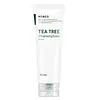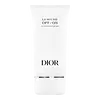What's inside
What's inside
 Key Ingredients
Key Ingredients

 Benefits
Benefits

 Concerns
Concerns

 Ingredients Side-by-side
Ingredients Side-by-side

Water
Skin ConditioningGlycerin
HumectantPalmitic Acid
EmollientStearic Acid
CleansingLauric Acid
CleansingPotassium Hydroxide
BufferingMyristic Acid
CleansingSodium Myristoyl Glutamate
CleansingTea-Lauryl Sulfate
CleansingPolysorbate 20
EmulsifyingBeeswax
Emulsion StabilisingGlyceryl Stearate
EmollientPEG-100 Stearate
Urea
BufferingAlcohol Denat.
AntimicrobialMelaleuca Alternifolia Leaf Oil
AntioxidantArachidic Acid
CleansingPhenoxyethanol
PreservativeChlorphenesin
AntimicrobialSalvia Officinalis Leaf Extract
CleansingLavandula Angustifolia Extract
Skin ConditioningMentha Piperita Extract
CleansingChamomilla Recutita Flower Extract
MaskingRosmarinus Officinalis Flower Extract
AntioxidantCaprylyl Glycol
EmollientDisodium EDTA
Ethylhexylglycerin
Skin ConditioningCapric Acid
CleansingTocopheryl Acetate
AntioxidantButylene Glycol
HumectantHydroxypropyl Methylcellulose
Emulsion StabilisingSodium Benzoate
MaskingDipotassium Glycyrrhizate
HumectantGaultheria Procumbens Leaf Extract
PerfumingSodium Chloride
MaskingWater, Glycerin, Palmitic Acid, Stearic Acid, Lauric Acid, Potassium Hydroxide, Myristic Acid, Sodium Myristoyl Glutamate, Tea-Lauryl Sulfate, Polysorbate 20, Beeswax, Glyceryl Stearate, PEG-100 Stearate, Urea, Alcohol Denat., Melaleuca Alternifolia Leaf Oil, Arachidic Acid, Phenoxyethanol, Chlorphenesin, Salvia Officinalis Leaf Extract, Lavandula Angustifolia Extract, Mentha Piperita Extract, Chamomilla Recutita Flower Extract, Rosmarinus Officinalis Flower Extract, Caprylyl Glycol, Disodium EDTA, Ethylhexylglycerin, Capric Acid, Tocopheryl Acetate, Butylene Glycol, Hydroxypropyl Methylcellulose, Sodium Benzoate, Dipotassium Glycyrrhizate, Gaultheria Procumbens Leaf Extract, Sodium Chloride
Water
Skin ConditioningGlycerin
HumectantLauric Acid
CleansingStearic Acid
CleansingSodium Methyl Cocoyl Taurate
CleansingMaltooligosyl Glucoside
Skin ConditioningPalmitic Acid
EmollientSodium Hydroxide
BufferingHydrogenated Starch Hydrolysate
HumectantParfum
MaskingGlyceryl Stearate
EmollientPEG-100 Stearate
Pentaerythrityl Tetrabehenate
EmollientNymphaea Alba Root Extract
Skin ConditioningDipotassium Glycyrrhizate
HumectantCoco-Betaine
CleansingPotassium Hydroxide
BufferingChlorphenesin
AntimicrobialSodium Cocoyl Isethionate
CleansingSodium Benzoate
MaskingPotassium Sorbate
PreservativeTocopherol
AntioxidantCitric Acid
BufferingCaprylyl Glycol
EmollientPolyquaternium-22
Water, Glycerin, Lauric Acid, Stearic Acid, Sodium Methyl Cocoyl Taurate, Maltooligosyl Glucoside, Palmitic Acid, Sodium Hydroxide, Hydrogenated Starch Hydrolysate, Parfum, Glyceryl Stearate, PEG-100 Stearate, Pentaerythrityl Tetrabehenate, Nymphaea Alba Root Extract, Dipotassium Glycyrrhizate, Coco-Betaine, Potassium Hydroxide, Chlorphenesin, Sodium Cocoyl Isethionate, Sodium Benzoate, Potassium Sorbate, Tocopherol, Citric Acid, Caprylyl Glycol, Polyquaternium-22
 Reviews
Reviews

Ingredients Explained
These ingredients are found in both products.
Ingredients higher up in an ingredient list are typically present in a larger amount.
Caprylyl Glycol is a humectant and emollient, meaning it attracts and preserves moisture.
It is a common ingredient in many products, especially those designed to hydrate skin. The primary benefits are retaining moisture, skin softening, and promoting a healthy skin barrier.
Though Caprylyl Glycol is an alcohol derived from fatty acids, it is not the kind that can dry out skin.
This ingredient is also used as a preservative to extend the life of products. It has slight antimicrobial properties.
Learn more about Caprylyl GlycolChlorphenesin is a synthetic preservative. It helps protect a product against bacteria in order to extend shelf life. In most cases, Chlorphenesin is paired with other preservatives such as phenoxyethanol and caprylyl glycol.
Chlorphenesin is a biocide. This means it is able to help fight the microorganisms on our skin. It is also able to fight odor-releasing bacteria.
Chlorphenesin is soluble in both water and glycerin.
Studies show Chlorphenesin is easily absorbed by our skin. You should speak with a skincare professional if you have concerns about using Chlorphenesin.
Learn more about ChlorphenesinDipotassium Glycyrrhizate comes from licorice root.
Extracts of licorice have demonstrated to have antibacterial, anti‐inflammatory, antiviral, antioxidant properties.
One component, glabridin, has extra potent antioxidant and soothing properties. It has also been found to block pigmentation from UVB rays in guinea pigs.
Licorice Root also contains a flavonoid. Flavonoids are a natural substance from in plants. Flavonoids also have antioxidant properties.
Another component, glycyrrhizin, has been found to have anti-inflammatory and antimicrobial benefits. This may make licorice root extract effective at treating acne. However, more research is needed to support this.
Liquiritin is one of the flavone compounds found in licorice. It has been found to help lighten skin by preventing tyrosinase from reacting with tyrosine. When the two react, protein is converted to melanin. Melanin is the substance in your body that gives your features pigmentation.
Licorice root is native to Southern Europe and Asia. It has been used in traditional Chinese medicine to help with respiratory issues.
Learn more about Dipotassium GlycyrrhizateGlycerin is already naturally found in your skin. It helps moisturize and protect your skin.
A study from 2016 found glycerin to be more effective as a humectant than AHAs and hyaluronic acid.
As a humectant, it helps the skin stay hydrated by pulling moisture to your skin. The low molecular weight of glycerin allows it to pull moisture into the deeper layers of your skin.
Hydrated skin improves your skin barrier; Your skin barrier helps protect against irritants and bacteria.
Glycerin has also been found to have antimicrobial and antiviral properties. Due to these properties, glycerin is often used in wound and burn treatments.
In cosmetics, glycerin is usually derived from plants such as soybean or palm. However, it can also be sourced from animals, such as tallow or animal fat.
This ingredient is organic, colorless, odorless, and non-toxic.
Glycerin is the name for this ingredient in American English. British English uses Glycerol/Glycerine.
Learn more about GlycerinGlyceryl Stearate is a mix of glycerin and stearic acid.
It is used to stabilize the mixing of water and oil ingredients. By preventing these ingredients from separating, it can help elongate shelf life. It can also help thicken the product's texture.
As an emollient, it helps soften skin and supports barrier-replenishing ingredients.
In cosmetics, Glyceryl Stearate is often made from vegetable oils or synthetically produced.
This ingredient may not be fungal-acne safe
Fun fact: The human body also creates Glyceryl Stearate naturally.
Learn more about Glyceryl StearateLauric Acid is a fatty acid or lipid. About half of fatty acids in coconut oil is lauric acid.
This ingredient helps hydrate and sooth skin. As a humectant, it helps trap moisture. It also aids in cleaning and enhancing the texture of products.
Lauric acid may not be Malassezia folliculitis, or fungal acne, safe.
Learn more about Lauric AcidPalmitic Acid is a fatty acid naturally found in our skin and in many plant and animal sources. In cosmetics, it is usually derived from palm oil. It serves many purposes in skincare, acting as a cleanser, emollient, and emulsifier.
As an emollient, palmitic acid helps soften and smooth the skin by preventing water loss. In cleansers, it helps remove oil and dirt while creating foam.
Its emulsifying properties help stabilize products by keeping water and oil-based ingredients from separating.
This may not be suitable for fungal acne-prone skin, as fatty acids like this can sometimes trigger breakouts in sensitive individuals.
Learn more about Palmitic AcidPeg-100 Stearate is an emollient and emulsifier. As an emollient, it helps keep skin soft by trapping moisture in. On the other hand, emulsifiers help prevent oil and water from separating in a product.
PEGS are a hydrophilic polyether compound . There are 100 ethylene oxide monomers in Peg-100 Stearate. Peg-100 Stearate is polyethylene glycol ester of stearic acid.
Potassium hydroxide is commonly known as caustic potash. It is used to fix the pH of a product or as a cleaning agent in soap. In cleansers, it is used for the saponification of oils.
Sapnification is the process of creating fatty acid metal salts from triglycerides and a strong base. During this process, Potassium Hydroxide is used up and is not present in the final product.
Using high concentrations of Potassium Hydroxide have shown to irritate the skin.
Learn more about Potassium HydroxideSodium Benzoate is a preservative. It's used in both cosmetic and food products to inhibit the growth of mold and bacteria. It is typically produced synthetically.
Both the US FDA and EU Health Committee have approved the use of sodium benzoate. In the US, levels of 0.1% (of the total product) are allowed.
Sodium benzoate works as a preservative by inhibiting the growth of bacteria inside of cells. It prevents the cell from fermenting a type of sugar using an enzyme called phosphofructokinase.
It is the salt of benzoic acid. Foods containing sodium benzoate include soda, salad dressings, condiments, fruit juices, wines, and snack foods.
Studies for using ascorbic acid and sodium benzoate in cosmetics are lacking, especially in skincare routines with multiple steps.
We always recommend speaking with a professional, such as a dermatologist, if you have any concerns.
Learn more about Sodium BenzoateStearic Acid is a fatty acid. It is an emollient, emulsifier, and texture enhancer.
As an emollient, stearic acid helps soften skin. It aids the skin's protective barrier by preventing water loss. It also provides a gentle cleansing effect without stripping away natural oils.
Stearic acid may also be used to enhance the texture of products. It can add volume and stabilize ingredients such as water and oil. This can help water and oil ingredients from separating.
Sources of stearic acid include animal or vegetable fats/oils such as coconut or shea. It can be naturally found in butter, cocoa butter, shea butter, vegetable fats, and animal tallow.
This ingredient may not be Malassezia folliculitis, or fungal-acne safe.
Learn more about Stearic AcidWater. It's the most common cosmetic ingredient of all. You'll usually see it at the top of ingredient lists, meaning that it makes up the largest part of the product.
So why is it so popular? Water most often acts as a solvent - this means that it helps dissolve other ingredients into the formulation.
You'll also recognize water as that liquid we all need to stay alive. If you see this, drink a glass of water. Stay hydrated!
Learn more about Water